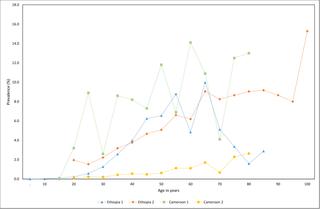PLOS Neglected Tropical Diseases ( IF 3.4 ) Pub Date : 2018-03-01 , DOI: 10.1371/journal.pntd.0006324 Kebede Deribe 1, 2 , Jorge Cano 3 , Mei L Trueba 1 , Melanie J Newport 1 , Gail Davey 1

|
Background
Podoconiosis is one of the few diseases that could potentially be eliminated within one generation. Nonetheless, the global distribution of the disease remains largely unknown. The global atlas of podoconiosis was conceived to define the epidemiology and distribution of podoconiosis through dedicated surveys and assembling the available epidemiological data.
Methods
We have synthesized the published literature on the epidemiology of podoconiosis. Through systematic searches in SCOPUS and MEDLINE from inception to February 14, 2018, we identified observational and population-based studies reporting podoconiosis. To establish existence of podoconiosis, we used case reports and presence data. For a study to be included in the prevalence synthesis, it needed to be a population-based survey that involved all residents within a specific area. Studies that did not report original data were excluded. We undertook descriptive analyses of the extracted data. This study is registered with PROSPERO, number CRD42018084959.
Results
We identified 3,260 records, of which 27 studies met the inclusion criteria. Podoconiosis was described to exist or be endemic in 32 countries, 18 from the African Region, 3 from Asia and 11 from Latin America. Overall, podoconiosis prevalence ranged from 0·10% to 8.08%, was highest in the African region, and was substantially higher in adults than in children and adolescents. The highest reported prevalence values were in Africa (8.08% in Cameroon, 7.45% in Ethiopia, 4.52% in Uganda, 3.87% in Kenya and 2.51% in Tanzania). In India, a single prevalence of 0.21% was recorded from Manipur, Mizoram and Rajasthan states. None of the Latin American countries reported prevalence data.
Conclusion
Our data suggest that podoconiosis is more widespread in the African Region than in the rest of the regions, although this could be related to the fact that most podoconiosis epidemiological research has been focused in the African continent. The assembled dataset confirms that comprehensive podoconiosis control strategies such as promotion of footwear and personal hygiene are urgently needed in endemic parts of Africa. Mapping, active surveillance and a systematic approach to the monitoring of disease burden must accompany the implementation of podoconiosis control activities.
中文翻译:

尘螨病的全球流行病学:系统评价
背景
Podoconiosis 是少数可以在一代人时间内消除的疾病之一。尽管如此,该疾病的全球分布在很大程度上仍然未知。全球足尘病图谱旨在通过专门调查和收集可用的流行病学数据来定义足尘肺病的流行病学和分布。
方法
我们综合了已发表的关于足尘螨病流行病学的文献。通过从成立到 2018 年 2 月 14 日在 SCOPUS 和 MEDLINE 中的系统搜索,我们确定了报告 podoconiosis 的观察性和基于人群的研究。为了确定是否存在足尘病,我们使用了病例报告和存在数据。要使一项研究纳入流行率综合,它需要是一项基于人群的调查,涉及特定区域内的所有居民。未报告原始数据的研究被排除在外。我们对提取的数据进行了描述性分析。本研究已在 PROSPERO 注册,编号 CRD42018084959。
结果
我们确定了 3,260 条记录,其中 27 项研究符合纳入标准。Podoconiosis 被描述在 32 个国家存在或流行,其中 18 个来自非洲地区,3 个来自亚洲,11 个来自拉丁美洲。总体而言,尘螨病患病率在 0·10% 到 8.08% 之间,非洲地区最高,成人明显高于儿童和青少年。报告的患病率最高的是非洲(喀麦隆为 8.08%,埃塞俄比亚为 7.45%,乌干达为 4.52%,肯尼亚为 3.87%,坦桑尼亚为 2.51%)。在印度,曼尼普尔邦、米佐拉姆邦和拉贾斯坦邦的单一流行率为 0.21%。拉丁美洲国家均未报告患病率数据。
结论
我们的数据表明,与其他地区相比,非洲地区的足尘螨病更为普遍,尽管这可能与大多数足尘螨病流行病学研究都集中在非洲大陆这一事实有关。组装的数据集证实,非洲流行地区迫切需要全面的足尘病控制策略,例如促进鞋类和个人卫生。绘图、主动监测和监测疾病负担的系统方法必须伴随着粉虱病控制活动的实施。











































 京公网安备 11010802027423号
京公网安备 11010802027423号